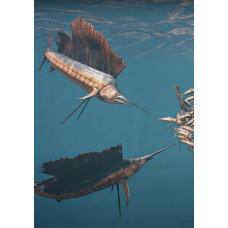Latin name
Istiophorus platypterus
Other names
Bayonet Fish, Bayonet-fish, Pacific Sailfish.
Identification
This species is characterised by the following features: slender, elongated and rather compressed, with a high, sail-like first dorsal fin; the upper jaw merges into a very long beak, thin and round in cross-section; jaws and palate bones with tufted teeth; absence of gill rakers; caudal peduncle with double keels on each side; body covered with small, depressed scales with 1 or 2 blunt ends; lateral line curved above the pectoral fin, then straight to the base of the tail.
Marine biologists speculate that the "sail" (dorsal fin array) of a fish may act as a cooling and heating system for the fish, due to the network of large numbers of blood vessels found in the sail and the "hoist the sail" behaviour.
Features of fish fins
Dorsal spines: 0; Dorsal soft rays: 47-53; Anal spines: 2; anal soft rays: 12-15. Has two dorsal fins, the first very long and large (42-49 rays), the second small (6-7 rays); pectoral fins 18-20 rays; pelvic fins 1, 2 soft rays fused together, very long and narrow, depressed in a hollow.
Fish colouring
Dorsal colour dark with about 20 bluish vertical stripes; belly pale silvery; first dorsal fin band blue-black with numerous dark spots; bases of first and second anal fins often silvery white; other fins blackish brown or dark blue.
Distribution
Tropical and temperate waters approximately 45°-50°N and 40°-35°S in the western Pacific, 35°N and 35°S in the eastern Pacific; 45°S in the western Indian Ocean and 35°S in the eastern Indian Ocean. Comes in the Mediterranean Sea from the Red Sea via the Suez Canal.
Habitat
Subtropical; pelagic-oceanic; oceanodromous; prefers 0-200 m depth range, usually 30-400 m.
Sailing speed
According to most sources, it is the fastest fish in the world. It can accelerate to more than 110 km/h (68 mph) in a short time.
Size
Maximum length: 348 cm; standard length: 270 cm. Maximum declared weight: 100.2kg. Maximum declared age: 13 years.
Behavior
A highly migratory species. It is solitary or moves in small groups. Communicates with each other by changing body colour.
Food and feeding habits
They have a large and sharp beak, which they use for hunting. They feed on tuna and mackerel, some of the fastest fish in the ocean.
Reproduction
Spawns throughout the year in tropical and subtropical waters of the Pacific Ocean, with peak spawning occurring during the local summer season. Spawning occurs when males and females swim in pairs or when two or three males pursue a single female (presumably mating behaviour). Mature ovarian eggs are approximately 0.85 mm in diameter and contain a single globule of oil; there are no structures on the vitalising membrane and the egg is transparent. Eggs released by a female captured in the Indian Ocean averaged 1.304 mm in diameter.
Fishing
In some areas this species is hunted, mostly as bycatch for tuna. The fish is not highly valued and is usually released.
Relationship with a person
A harmless species. Edible fish.
| Classification | |
| Phylum | Chordata |
| Class | Actinopterygii |
| Squad | Istiophoriformes |
| Family | Istiophoridae |
| Genus | Istiophorus |
| Species | I. platypterus[ |
| Features | |
| Conservation status | Least Concern |
| Habitat | Pelagic |
| Life span, years | 13 |
| Maximum body weight, kg | 100,2 |
| Maximum length, cm | 348 |
| Sailing speed, m/s | 30,6 |
| Threat to people | Edible |
| Way of eating | Predator |
Indo-Pacific sailfish
Tags: indo pacific sailfish



